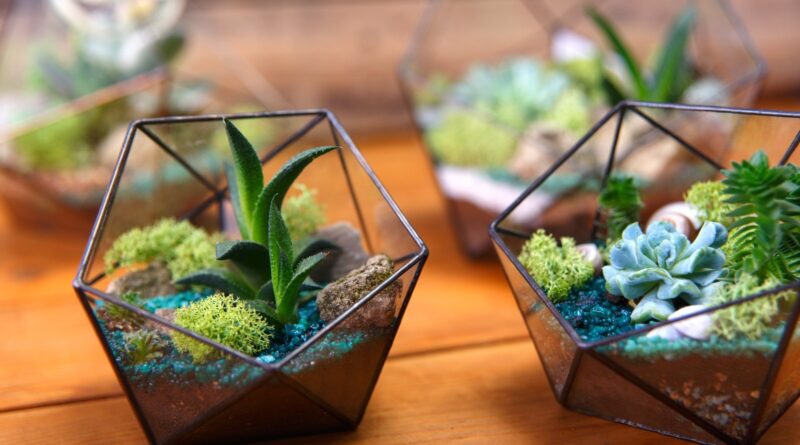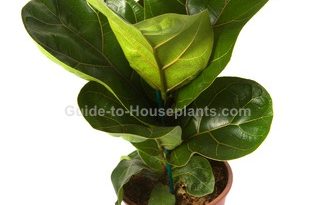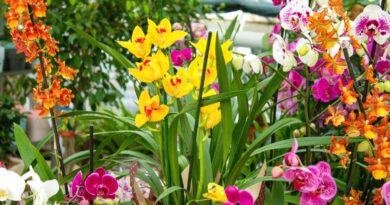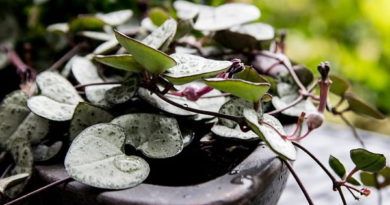15 Unique Terrarium Design Ideas You Should Try
Houseplant trends are always evolving, and at the moment, terrariums are in the spotlight. These mini-ecosystems provide a little more creative expression compared to what you get from purchasing a houseplant, bringing it home, and maybe placing it in a decorative pot cover.
For artistic indoor gardeners or those who just want a fun weekend project to try, terrariums are ideal. And if you’re looking for inspiration beyond potting a few suitable plants in a jar, these 15 ideas will help you out.
Play With Layers

When layering your terrarium, instructions will usually tell you to shake the glass gently between each layer to ensure the sections are even. However, intentionally keeping your soil uneven can actually create more interest, giving your terrarium a dynamic and natural look.
In this terrarium, a valley is created by building up the soil on two sides. The different heights make the features, including the rocks and the plants, much easier to see than they would be in a standard flat terrarium.
The only downside is the display. You need to angle your terrarium carefully to be visible from the open side. Otherwise, you’ll have people asking why you have a jar filled with only soil on display in your home.
Geometric Succulent Garden

Terrariums are meant to be closed systems that are largely self-sustaining. Since succulents can only live in open jars (they will likely rot in a closed system), the existence of a true succulent ‘terrarium’ is up for debate. However, they have become one of the most popular options thanks to their low maintenance, so with their many benefits, I think we can let definitions and semantics slide.
In succulent terrariums, the geometric forms and unique textures of the plants are usually the highlight. But you can emphasize these sharp shapes more with an angled vase. This is not only good for design purposes, but it also improves airflow around the plants, keeping them happy.
Growing succulents in an enclosed space without drainage is risky if you want them to stay alive long-term. If you’re going to try crafting a succulent terrarium, it’s essential to water incredibly carefully to stop the soil from becoming soggy.
Forest In A Jar

My favorite additions to terrariums are tree-like plants that make the entire jar look like a tiny forest. The height and shape created by these plants put everything else in the terrarium into perspective, creating a landscape look rather than a simple collection of plants in a jar.
Bonsai trees seem like the obvious choice as they are literally tiny versions of tree species, but you may run into some problems with long-term growth in a terrarium. Bonsai trees require special care and attention to maintain their shape, and that care can be incredibly tricky when the tree is stuck inside a jar.
Instead, I would opt for tropical plants that have a tree-like shape. My go-to is the jade plant, although its succulent stems can rot quickly with too much water. If you do want to use a bonsai tree, opt for beginner-friendly and humidity-loving genera like Ficus.
Pop Of Color

For the bold maximalists out there, your terrarium can easily reflect your style if you choose your plants carefully. Several plants suitable for terrariums have bright and eye-catching leaves to add a pop of color to your home. These colors are even brighter when grouped together, creating an almost luminous display.
This terrarium features different varieties of nerve plant, scientifically known as Fittonia. These plants are sought after for the contrasting colors along the veins that give the plant its common name. There is harmony in leaf shape and height, emphasizing the difference in color between each plant.
Another great colorful option is the polka dot plant, Hypoestes phyllostachya, with mottled leaves in pink, red, white, and green. Some flowering plants can also grow in terrariums with a bit of extra attention, including African violets and certain species of orchid.
New Orientation

Who said a terrarium jar has to sit upright? You can fit far more plants into a taller jar if you simply lay it on its side and plant horizontally. This terrarium features shorter plants – mosses and nerve plants with a few decorative elements – that look good without taking up too much vertical space.
There are a few caveats to consider when trying this design. For starters, the opening of your jar needs to be lifted slightly so you can plant without soil spilling out. In this terrarium, the soil tapers off, so it’s not near the opening, but that might not be possible for all jar types.
You also need to consider stability. If your jar can comfortably sit on its side and not move even though it’s rounded, you’re good to go. If it tends to roll around on its side, you’ll need to hold it in place and display it carefully to stop your hard work from tumbling into a mess.
Add Stairs

Another way to transform your terrarium into a tiny landscape is by adding these adorable stairs. Stairs add height and perspective to a terrarium, especially when paired with taller plants in a large container. They can instantly elevate your terrarium design with very little effort.
These stairs are made from flattened pebbles, but you can use any small and flat elements that can mimic a stair-like structure. I would caution against using untreated wood, though, as it can rot and develop mold. I tried building stairs in a terrarium with tiny wooden log rounds, and they didn’t last very long.
When building, start by layering your soil at a slight angle. Make holes and plant first, leaving space for where you want the stairs to be. Then, slot the pebbles in last from the top down so you don’t end up covering them with soil.
Go Beyond Plants

Plants are obviously the highlight of any terrarium. But they’re not the only element you should think about when coming up with your design. Decorative rocks or pieces of driftwood can become the centerpiece of your terrarium design, adding a structure and texture that you may be missing in plants alone.
In this terrarium, two decorative rocks are dotted between the plants. They anchor everything in place, creating height and a backdrop for the leaves to shine. Without them, the gap in the center would look empty, making the entire terrarium appear sparse.
I also like to include pieces of driftwood as a sculptural element in a similar way to rocks. You can use them for height and even plant in any gaps in the driftwood or use them to anchor air plants in open terrariums.
Hanging Gardens

If you don’t have any surfaces to rest your terrarium on, plant up a hanging terrarium instead. There are hanging terrariums for sale online, but if you purchase just the glassware, you can get creative with the design.
These hanging terrariums feature single succulents, having more of an impact when grouped together. I have owned one of these terrariums in the past, and you need to water it carefully and hang it in a very sunny spot to prevent stretching that can impact the overall look of the terrarium.
If you have a larger hanging jar, you can group a few plants together. For open terrariums with holes on the sides, I would include a trailing succulent, like string of pearls, along with a taller feature succulent to add height.
Tropical Oasis

Tropical plants are ideal for terrariums because of the high-humidity environments they create, replicating the jungle-like conditions many houseplants come from. Use this to your advantage by combining lush, leafy plants to form a tiny tropical oasis.
Many plants in the arum family work well in terrariums, including philodendrons, peace lilies, and alocasias. You can also use anthuriums in larger jars to add a pop of color, as long as they are placed in a bright enough area.
In this terrarium, tropical plants are paired with lush ferns – a go-to plant for terrariums due to their love of moisture and high humidity. If you struggle to keep your ferns alive due to low humidity or forgetful watering, planting them in a terrarium may be the answer to all your problems.
Desert Sands

For almost opposite conditions to a tropical feature, you can also create a tiny desert-like environment for your terrarium design. This style is suitable for planting low-maintenance succulents and cacti that require little attention.
The key to replicating the desert look, rather than just potting a few succulents in a jar, is the sand itself. The layers of gravel and fine, warmly-toned sand instantly remind us of sprawling deserts, with rocks and spiky cacti blending in seamlessly.
A desert terrarium will need a little more direct sun to stop the cacti and succulents from stretching. Avoid adding too much water to the soil to prevent root and stem rot. I like to water with a straw in these types of terrariums to target the moisture around the roots and prevent accidental overwatering that’s almost impossible to fix in a glass jar.
Terrarium Pendants

Take your love of terrariums to the extreme by keeping them with you at all times in a tiny jar. These adorable terrarium designs are not difficult to put together. All you need is a little gravel, a tiny amount of soil, and some moss.
But what makes them different is the chain around the jar, allowing you to use these living decorations as pendants. Use them as a necklace, hang them on your wall, or use them as Christmas tree ornaments – their size makes them incredibly versatile.
If you don’t want to use moss, you can also keep tiny succulents in small jars, as we’ll see next.
Succulent Pendants

Tiny succulents are ideal candidates for short-term terrariums, providing a different look from the mossarium before. A combination of sand and gravel with a little moisture will keep the succulent alive for several weeks, perfect for a living decorative display.
Unfortunately, these terrariums don’t last long. Most succulents don’t stay that small for long and will quickly fill the remaining space. But you might run into another problem before that happens that can kill off the plant altogether – rot.
If you’re happy for your terrarium to only live for a few weeks, you can give this display a try. Choose succulent species with small pups, as these are ideal for removing and potting into a terrarium.
Colored Gravel

To add some extra creativity to your terrarium design, play with the layers in the jar, not just the plants themselves. These jars do have pops of color in the plants used (nerve plants are the highlight again, as in the terrarium before). But what really stands out is the layers of white gravel that create a dramatic contrast against the dark soil.
I do have one warning about trying designs like this: getting the layers perfect is not an easy task. I can be quite impatient with finicky activities, and seeing tiny stray pieces of gravel in layers they weren’t supposed to be in was incredibly frustrating.
But if you’re willing to go slow and carefully place each layer to create those defined lines, the effect is well worth the effort.
Bulb Vase

One bright idea for a unique terrarium vase – excuse the pun – is planting in an old lightbulb. I have made hanging vases from lightbulbs, and it’s not as difficult as it might seem, although you do need to handle it carefully to avoid damage to the glass (and your hands).
Once you’ve removed the end and inside of the bulb, fill it with soil and toss a few tiny plants in. Moss typically works best due to the limited space inside the bulb. You can hang the bulb upside down from the ends or glue it to a stable surface to keep it upright.
This terrarium design is a great way to recycle old used bulbs that would otherwise go to waste. Seal the ends or keep them open to change up your design later on.
Carnivorous Terrarium

One plant you may not have considered keeping in a terrarium is the Venus fly trap, one of the most iconic carnivorous plants in the world. These plants come from bog environments where the soil is consistently moist, making terrariums a surprisingly ideal environment for them.
This display combines a few different plants, but the highlight is undoubtedly the Venus fly trap. The open jar allows for extra airflow to prevent rot and also makes it easier to add more moisture as the soil starts to dry out.
Plus, keeping the jar open allows the traps to do their job of clearing out annoying flying bugs in your home, providing essential nutrients at the same time.
Final Thoughts
These are just some of the many unique terrarium ideas even beginners can try at home. Use them as inspiration to create your own creative display.




